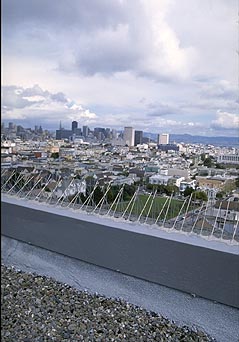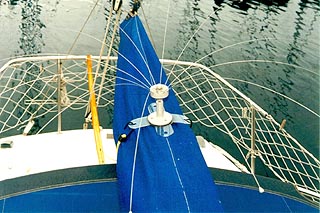|
Subscribe / Renew |
|
|
Contact Us |
|
| ► Subscribe to our Free Weekly Newsletter | |
| home | Welcome, sign in or click here to subscribe. | login |
Construction
| |

June 8, 2000
Company has the poop for keeping birds away
Journal Staff Reporter
From sidewalks messed with droppings to gutters filled with feathers, birds aren’t always welcome in some public places. As beautiful as they can be individually, a large group of birds gathering atop a building or nesting in air vents can create a danger for themselves and the public.

|
Bird Barrier Inc. of Carson, Calif., has developed several ways to keep birds off building ledges and awnings without harming them and with little to no visual impact.
"You probably won’t even notice them," says Monique Thorsell, marketing director for Bird Barrier, of the company’s various, and often strange-looking, bird deterrents.
Some of their products -- such scarecrow-like screech owl decoys -- have been used for years. Others -- like the Daddi Long Legs with its many thin, wavy wires -- look more like alien technology.
Though Bird Barriers has been around for eight years, Thorsell says some of its experts have been working in bird control for 20 years. "It has grown to be a very hot market in the last seven to eight years," she said. As more development moves into the suburban areas, birds are finding their old nesting grounds are now covered in pavement. "We’re decreasing their natural habitat," she says. "There are more conflicts being created."
In recent years, increasing populations of Canadian Geese have left their mark -- and droppings -- on public parks and golf courses. Some are concerned the birds will destroy the landscaping and vegetation -- others worry about diseases spreading through bird droppings.
In the city, birds create problems when they gather on rooftops where their feathers and droppings get into air vents, either circulating bacteria or causing mechanical problems. "You really want to keep birds off the air intake valves and air conditioning units," Thorsell says. A lot of times they will clog up gutters, creating standing water that can wear down a roof.
The issue isn’t really with one or two birds hanging out on a ledge outside of the building, she says. "But if you have them in an area around the air conditioning unit or if you have a couple hundred birds on the building, you need to take a look at solving the issue."
Contractors and homeowners can purchase products on Bird Barriers' Web site. The company will provide teaching tools on which method will work best for the situation and how to install the product. "We don’t actually do the installs," she said, but the company has trained more than 15,000 installers across the country.
Different products are recommended for different situations. The StealthNet is made of polyethylene twine and steel installation hardware, so it is difficult for the public to see from even a few feet away. Designed for all bird species and heavy use, the netting is attached to a pre-installed cable system. Though great for keeping birds off rooftops and air conditioning units, the installation of the StealthNet is rather involved.
Another product, Bird-Flite Spikes, comes in one-foot lengths and three different width configurations. The product is designed to keep birds the size of pigeons or larger off ledges, while leaving room for small songbirds. Made of stainless steel and polycarbonate, the base can be easily glued or screwed onto the surface.

|
The spider-like Daddi Long Legs is made of stainless steel and Delrin plastic. This product is often used on boats, atop streetlights and outdoor shade umbrellas to deter bigger birds from landing. "Not starlings or sparrows," Thorsell says. "They can actually hang on the wires."
The cost of installing a bird-deterrent system can vary depending on the product used and the extent of the project. "The homeowner that has a problem on their window ledge could spend $20 to $30," she said, whereas keeping birds out of airport hangers could cost more than $100,000. "In general, the solution to the problem is anywhere from $500 to $2,500."
At Seattle’s Key Arena, Bird Barrier products such as the Bird Flight and Bird Shock are used to keep birds away from and out of the building. While Bird Shock does generate an electric shock, Thorsell says it won’t actually harm the birds. "It sends a little conditioning shock, similar to a static-electricity shock," she says.
In fact, the Humane Society and the Fund for Animals have endorsed Bird Barrier because the company provides non-harmful methods to deter birds. "We have the only completely humane product line in the business," Thorsell says.
Lisa Lannigan can be
reached by email or by phone
at (206) 622-8272.
Previous columns:
- Creating a little desert indoors, 06-01-2000
- Living in a cardboard house, 02-24-2000
- $17 million emergency center spurred by fire training tower, 01-13-2000
- Landscape problem? Cover it with a 'rock', 01-06-2000
- Life on the leading edge of sustainability, 12-23-1999
- Commuter Building now a traffic-stopper, 11-18-1999
- Permeable pavement can reduce storm runoff, 11-04-1999
- Job order contracting may come to local agencies, 10-28-1999


